Although the familiar expression “the ends justify the means” is often attributed to Machiavelli because of concepts he discussed in The Prince, Nechayev, a
19th-century Russian revolutionary, coined the phrase. While we can easily relate this to our current political climate, this article is about the application of this concept to investing.

To be fully relevant in the world of investment management, we can substitute a couple of words to this expression: ends equal investment results; and means equals process. So, do investment results make process irrelevant?
Our view is that the only logical way to justify this question is to assume historical results are reliable predictors of future ones. However, we know how regulators feel about this (“Past performance is not necessarily indicative of future results” — more on that below), and our own analysis on the predictiveness of historical results on future performance suggests the answer to the question is an emphatic “NO.”
To be clear, Segal Marco Advisors does believe that an objective evaluation of past performance is a critical component in assessing an investment manager and strategy. However, this is simply one part of a time-tested, multi-stage process we use to identify best-in-class investment managers and strategies that we believe leads to better outcomes for our clients.
Behavioral biases and investment performance
In investing, one of the most difficult things to do is to avoid behavioral biases, of which all humans are prone, which tend to be counterproductive to sound decision-making. Tim Barron, our Chief Investment Officer, recently published an article, “The Tyranny of Behaviorism,” which touches on several behavioral biases and how they are made manifest in the decisions of investors.
One such bias is herding — the natural tendency for humans to follow the crowd without sufficient rationale. It is no mystery that managers tend to receive large inflows of capital after periods of strong performance. Many people believe that past performance is indicative of future results, despite what regulators and financial experts tell them.
Our analysis, however, suggests a different conclusion — that giving all your money to the top-performing manager over the most recent period solely on the basis of performance is, in fact, a poor decision!
Our analysis
We sought to determine whether the performance of the top managers in any given period is persistent into future periods. Across several asset and sub-asset classes, we identified the top- and bottom-quartile managers for two five-year periods (2009–2014 and 2011–2016) and observed how they performed relative to their peers in the subsequent period five-year periods (2014–2019 and 2016–2021). This analysis yielded similar results across equity sub-asset classes, offering little to no support for manager performance persistence even among the top managers. Fixed Income tells a different story, with consistent performance across several periods among both top- and bottom-quartile managers.
Looking at one of the most efficient areas of the equity markets, U.S. Large Cap, subsequent performance of top- and bottom-quartile managers is quite mixed across both value and growth styles. While an argument could be made that top performers in these sub-asset classes have a stronger tendency to remain in the upper half of managers for the following period (and vice versa for the worst performing managers), the data proves that past performance has only a weak correlation to future success.
For example, Exhibit A shows that only 32 percent of top-quartile U.S, Large Cap Growth managers for the five-year period ending September 30, 2014 remained in the top quartile of performance for the subsequent five-year period. The percentage of managers demonstrating persistent top quartile performance is even lower from 2016–2021 and, in fact, half of the top performers from the five-year period ending September 30, 2016 fall below the median for the subsequent five-year period. Conversely, managers that fall in the bottom quartile over a five-year period tend to remain below median over the next five years, an indication that identifying the top performers on a go-forward basis is more difficult than avoiding the worst performers.
Exhibit A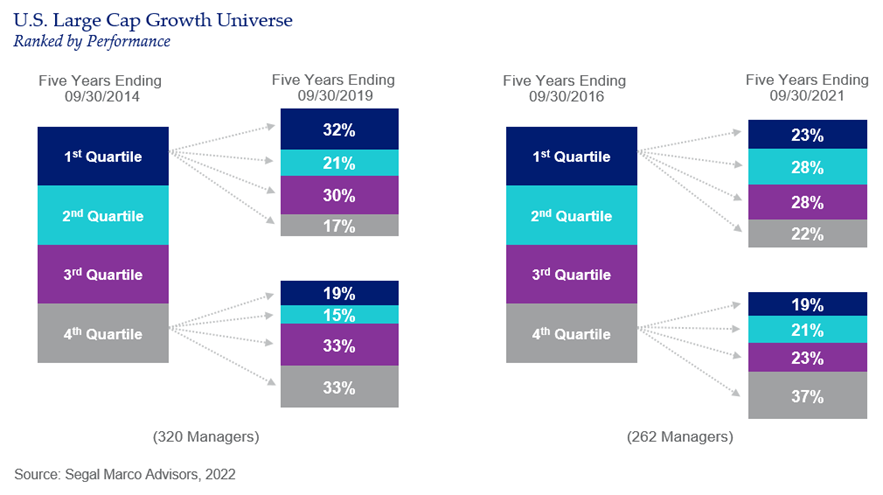
A similar dynamic exists in the Large Cap Value universe, as shown in Exhibit B.
Exhibit B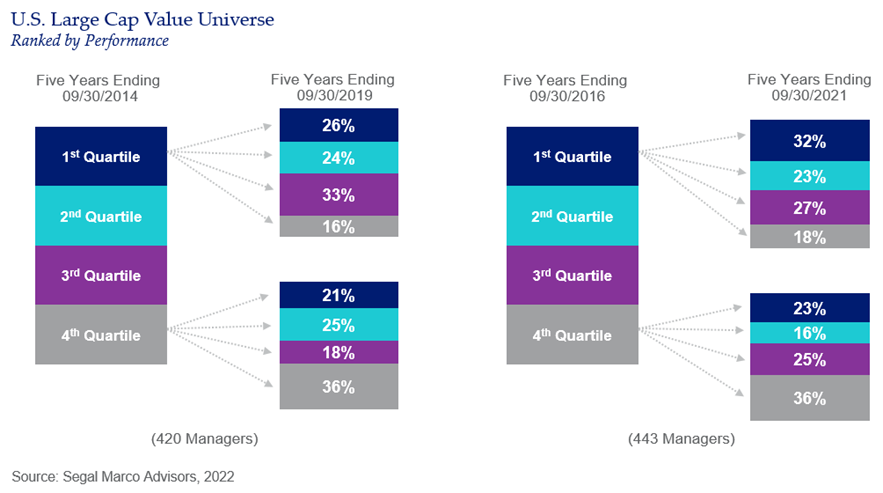
The same analysis of U.S. Small Cap equities showed an even weaker relationship between past and future performance. Among U.S. Small Cap growth strategies, more than 40 percent of bottom-quartile managers ended up in the top quartile for the following period, as shown in Exhibit C. Across the rest of the small cap spectrum, there is no evidence supporting the idea of performance persistence.
Exhibit C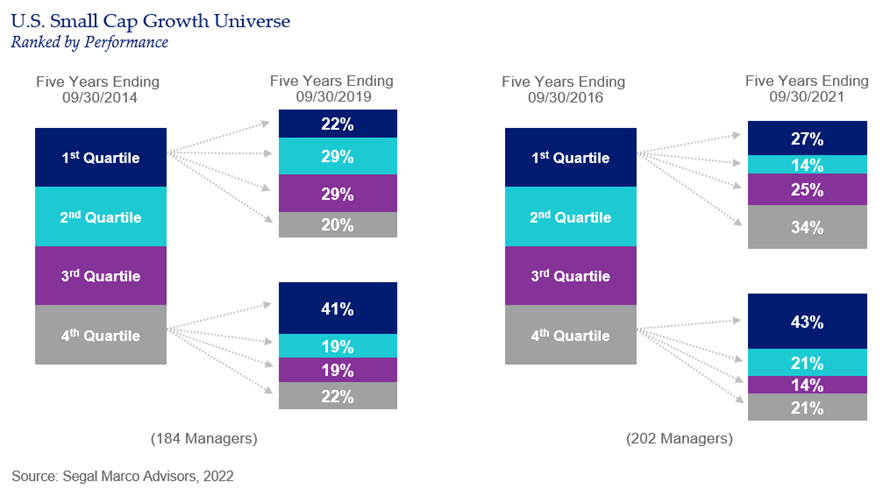
Exhibit D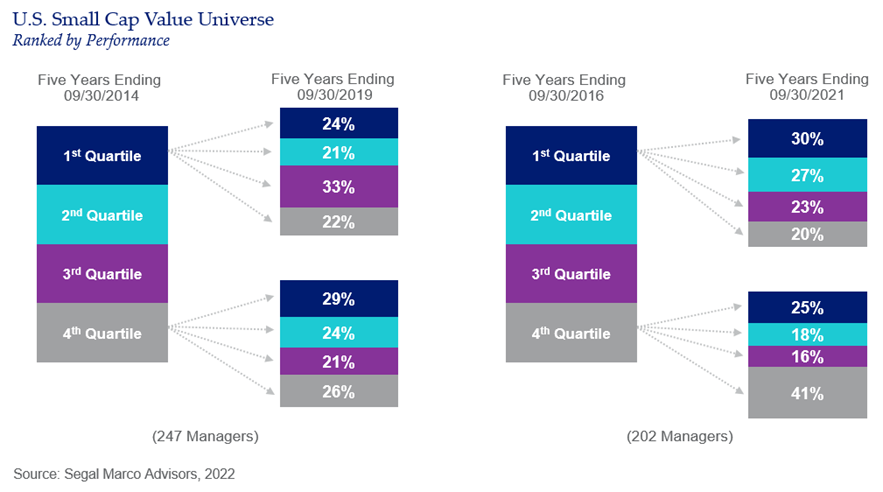
Results are somewhat better outside the U.S. As Exhibit E shows, upwards of 60 percent of top-quartile managers outperformed the median in the following five-year period, and as high as 73 percent achieved above-median performance for the period ending September 30, 2019. Bottom-quartile managers had similar results but to the downside: upwards of 70 percent ended up in the bottom half for the next period.
Exhibit E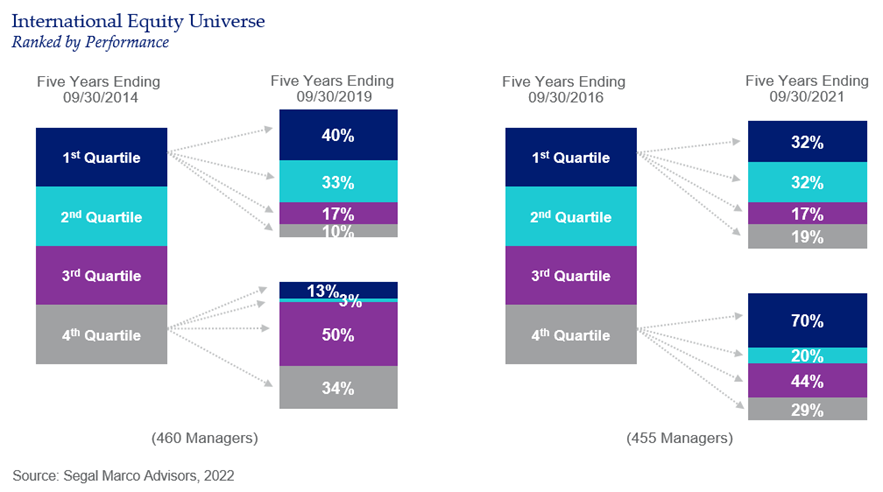
Perhaps unsurprisingly, performance appears to be most persistent in U.S. Fixed Income, as shown in Exhibit F. The overwhelming majority of top-quartile managers remained in the top quartile for the following period. Similarly, more than 80 percent of bottom-quartile managers remained in the bottom quartile for the following period.
This dynamic is likely attributable to a few important factors. First, fixed income exhibits lower volatility than equities, which means returns tend to be more persistent and drawdowns less severe. Second, until recently, interest rates have generally fallen for more than 30 years, with a few brief exceptions. This means bond prices have been rising for quite some time, leading to more stable returns. This dynamic also results in managers having been rewarded for taking more risk in their fixed income strategies. Those with higher allocations to credit have persistently done well. Of course, this can change in periods of dislocation, such as what we have seen recently.
Exhibit F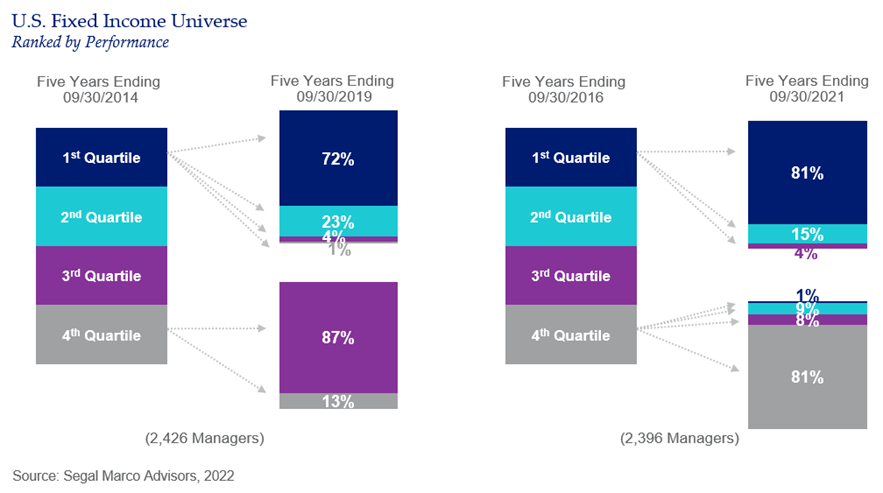
When evaluating investment managers, consider more than past performance
For many investors, performance is the ultimate evaluation of an investment decision — if an investment performs well, it was a good decision and if it performs poorly, well, you get the idea. Unfortunately, in evaluating the forward-looking prospects of an investment or an investment manager, many investors also believe that past performance is indicative of how an investment will perform in the future.
At Segal Marco Advisors, we believe a more robust evaluation framework that extends well beyond historical performance is needed to not only analyze the success or failure of decisions, but also to identify top-performing managers and investments. The world of investing is one of uncertainty. The ends are only known through hindsight and, for those without that benefit in making decisions, we believe the means are a critical component of ensuring long-term success with their investment portfolios.
See more insights
The information and opinions herein provided by third parties have been obtained from sources believed to be reliable, but accuracy and completeness cannot be guaranteed. This article and the data and analysis herein is intended for general education only and not as investment advice. It is not intended for use as a basis for investment decisions, nor should it be construed as advice designed to meet the needs of any particular investor. On all matters involving legal interpretations and regulatory issues, investors should consult legal counsel.
